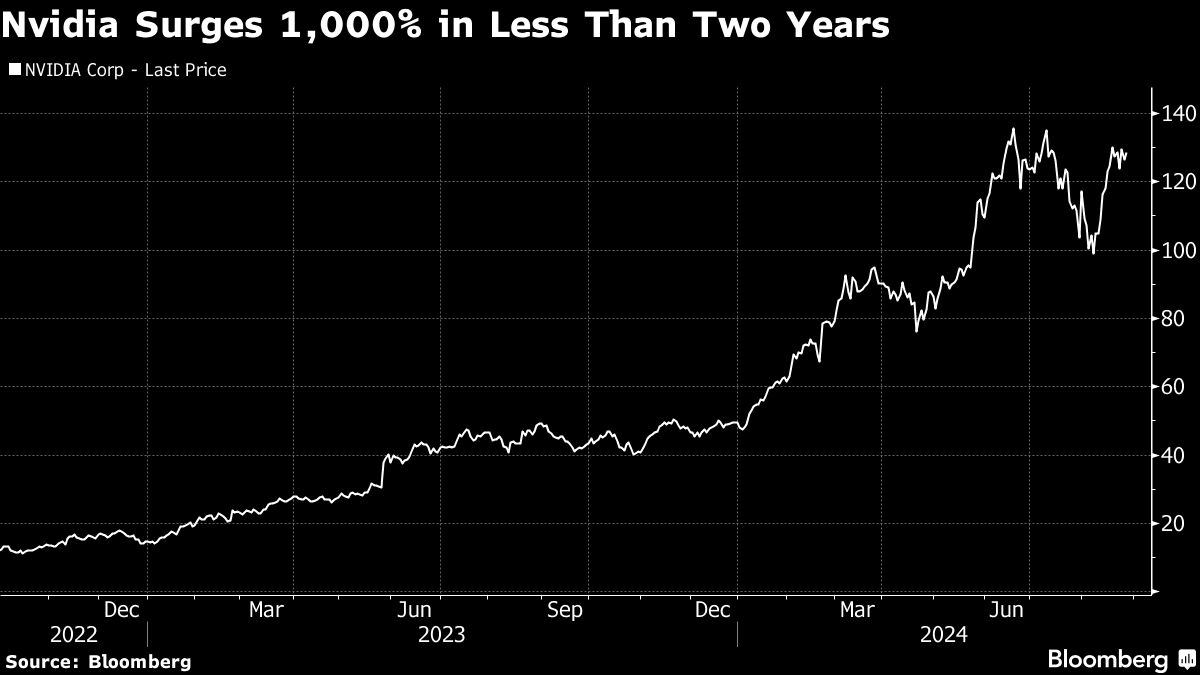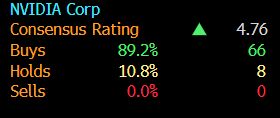
(Aug 28): Stocks hovered near all-time highs, with traders awaiting Nvidia Corp’s results for clues on whether the artificial intelligence (AI) euphoria that’s powered the bull market has more room to run.
Just a day ahead of the giant chipmaker’s earnings, investors are getting ready to see whether the AI darling will at least match Wall Street’s lofty estimates. Given its massive influence on broader indices, Goldman Sachs Group Inc’s trading desk has once called Nvidia “the most important stock on planet Earth.” A member of the “Magnificent Seven” group of megacaps, the company has been responsible for over a third of the Nasdaq 100’s gain this year.
Investors are gearing up for big swings in Nvidia’s shares after the US$3.2 trillion (RM13.9 trillion) company led by Jensen Huang reports earnings on Wednesday. Trading in the options market implies a nearly 10% move in either direction on the day following the results. The stock has rallied about 160% this year and 1,000% from its October 2022 bear-market low.
“Nvidia’s earnings report may actually have more impact on the overall market than Jerome Powell’s Jackson Hole speech last week,” said Anthony Saglimbene at Ameriprise Financial. “Move over, Powell. It’s Jensen Huang’s turn to move markets.”
To Chris Senyek at Wolfe Research, Nvidia’s results will set the tone for markets before the key US payrolls report on Sept 6.
“We remain bullish, but risks are now skewed to the downside over the very near term. From a seasonal perspective, we enter a weaker period that is even more amplified in election years,” Senyek said.
The S&P 500 edged up to around 5,625. The Nasdaq 100 rose 0.3%. A closely watched gauge of chipmakers added 1.1%. Nvidia climbed 1.5%. Software firm Salesforce Inc, which also reports results on Wednesday, fell 0.4%. Super Micro Computer Inc slid 2.6% after Hindenburg Research said it’s short the maker of server equipment. The Russell 2000 of small caps dropped 0.7%.
Treasury 10-year yields rose one basis point to 3.83%. A US$69 billion US sale of two-year notes was well-received. Oil fell as technical measures signaled a three-day rally driven by the threat of a halt to Libyan supplies was overdone.
With questions swirling around Federal Reserve policy, the state of the economy and the US presidential race, at least one thing seems clear on Wall Street: spending on AI is still key.
Concerns about the returns of those investments recently contributed to a tech selloff, although that dip was readily bought. AI hardware and chip companies have led the bounce in the Nasdaq 100 from its August low, with Nvidia up about 30%.
Nvidia accounts for more than 6% of the S&P 500’s market cap in terms of its index weight, so “it’s increasingly a bigger component of where the trend and momentum of the market goes,” Matt Stucky of Northwestern Mutual Wealth Management told Bloomberg Surveillance. If the giant chipmaker fails to deliver, or even just meets expectations, “I think it’s more of a risk-off environment,” he said, “not necessarily fuel for rotation.”
Analysts, on average, are predicting that the giant chipmaker will project revenue growth of more than 70% for the current quarter. Some are estimating an even larger surge. Nvidia’s results and forecast also will serve as a barometer for AI spending across much of the technology industry.
While there have been reports that some versions of Nvidia’s new Blackwell chip lineup are delayed, most analysts believe there’s sufficient demand for current products to make those snags immaterial. The company hasn’t yet commented on the matter.
“Nvidia is likely to solidly beat consensus and raise third-quarter guidance, with sales surpassing estimates by a single-digit percentage,” said Kunjan Sobhani at Bloomberg Intelligence (BI). “Yet concerns about the Blackwell chip delay could weigh on the upside to expectations for fiscal 2025, making management’s comments — especially a reassuring 2025 outlook — critical.”
Despite the potential for near-term volatility in tech, the AI growth story remains intact, according to Mark Haefele at UBS Global Wealth Management.
“Nvidia’s results this week as well as Apple’s upcoming iPhone launch will be key catalysts to watch. Without taking any single-name views, we maintain our positive outlook for quality AI beneficiaries in the semiconductor and software industries,” Haefele said.
It’s difficult to recall a period in the past where the earnings of one company have been so focused on by the market, but that is where we stand now on Nvidia and to a lesser extent Broadcom Inc, according to Ryan Grabinski at Strategas.
“Their respective earnings results will be a significant catalyst for the broader market in either direction,” he said. “A miss from Nvidia — which has an EPS (earnings per share) contribution of 4.6% — could swing estimates materially. Broadcom, which reports next week, contributes 1.6%. A less material EPS contribution, but just as important for ‘AI enthusiasm’.”
Throughout its history, Nvidia has been in a 38% average drawdown, according to data compiled by Bespoke Investment Group strategists.
“Our goal here is not to suggest that Nvidia is doomed, but rather to temper expectations,” Bespoke said. “A repeat of the 1,000%+ gain already experienced by Nvidia is virtually impossible, and extreme pullbacks in a volatile stock like this can happen at any time.”
As the earnings season winds down, BI notes that AI mentions in second-quarter earnings appear to have slipped quarter over quarter — but that’s likely because companies Nvidia and Salesforce have yet to report.
“Recession references among S&P 500 companies’ management and in analyst questions ticked up quarter over quarter for the first time since 2Q22,” said the BI strategists led by Gina Martin Adams. “Still, macroeconomic topics have taken a back seat to AI and the consumer.”
On the economic front, data showed US consumer confidence rose to a six-month high in August as more upbeat views of the economy and inflation offset waning optimism about the labour market.
While the S&P 500 is now nearly back to its all-time high in the wake of Powell’s recent dovish message, underlying risk premia are still somewhat larger than before the July correction began and the previously all-conquering “AI” narrative still is yet to fully recover, according to Jonas Goltermann at Capital Economics.
“Provided that the US economy manages a soft landing, as we continue to anticipate, and enthusiasm around AI rebounds further, we forecast the S&P 500 will hit 6,000 by the end of the year,” he said.
Bank of America Corp clients pulled money from US stocks for the first time in three weeks, paring their exposure in the asset class that continued to hover near a record. The offloading was seen across seven of the 11 industry groups but was most prominent in technology stocks, which saw their first outflow in three weeks.
Though the recent rally in Treasuries helped bring the stock-bond relative value comparison back near the long-term average, equities still suffer limited appeal on yields, according to BI’s Adams.
The S&P 500 equity risk premium — the spread between the earnings yield on stocks and the yield on the 10-year Treasury — has edged back into positive territory, Adams noted. However, right at its long-term average, it is still too low to support the notion of strong forward returns like it did in the 2010-19 bull market, she noted.
“Due to the combination of higher bond yields and stocks near all-time highs, the equity risk premium suggests merely average future returns for stocks — a far cry from the double-digit annualised returns that characterised the post-financial crisis era — but still positive nonetheless,” the strategist concluded.
Uploaded by Isabelle Francis





